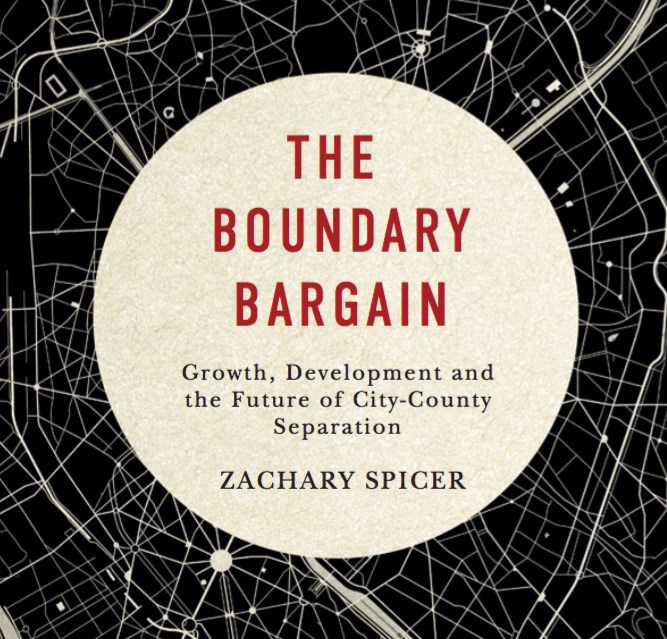The great divide between town and country — or city and county — in Ontario was entrenched in cultural attitudes, municipal structures, and provincial policies for over a century.
Those walls have gradually come down, but in some places, including in the relationship between the City of Guelph and Wellington County, some of those dividing lines remained entrenched.
Zachary Spicer, an assistant professor of political science at Brock University, has used the Guelph/Wellington relationship as a case study in his new book The Boundary Bargain: Growth, Development and the Future of City-County Separation.
Things have changed in the relationship, he said in an interview, but they’ve also stayed the same. While it has become increasingly untenable to maintain the division, given the manner in which population growth and economic development have unfolded in recent times, personalities can have a lot to do with whether the relationship is cooperative or disobliging.
These relationships, Spicer said, are rooted in longstanding attitudes.
“For most of our history, the province really viewed rural and urban as distinct and separate, as really having nothing to do with each other,” Spicer said in a telephone interview. “People living in rural areas viewed cities as dirty and dangerous, as places of vice where you would go to be corrupted.”
Separating city and county using institutional means was a way to keep nasty urban values from spreading to the rural areas, he said.
“And cities didn’t want to be bogged down in the narrowly focused politics of rural life, so they had no problem being formally separate,” he said.
It wasn’t until rapid population growth took hold that the province began to see rural and urban as having a greater sense of connection. Municipal amalgamations brought both urban and rural areas under the same regional governance model.
“Places like Guelph and Wellington are kind of stuck in the old institutional framework,” Spicer said.
One of the problems with this more traditional framework is that there is no mechanism for cooperation, and no ability to share the benefits of growth, such as taxation and development revenues.
Growth spills over city boundaries into surrounding counties, creating competition between city and county. Traditionally, the city would interpret this growth as belonging to them, because there was an “old bargain” that growth happened in cities, while rural areas stayed rural.
“But now rural areas see growth as being beneficial, where small sections of new homes and townhouses makes sense to them,” Spicer said.
Some attitudes have changed, but cities continue to see residential growth around their borders as originating from and belonging to them, he said. That causes tension and inequity.
Another challenge, and one that is particularly prevalent in the Guelph/Wellington scenario, is that there is a lingering perception that some services are specifically rural and others exclusively urban.
“Guelph and Wellington County’s relationship has been fairly good on the growth side,” Spicer said. “Unlike London, the county has sort of allowed Guelph to grow and expand, and to annex rural territory so they could remain part of the city.”
But the so-called consolidated municipal service management system, involving the downloading of social services under the Mike Harris government, caused a major rift in some areas, especially between Guelph and Wellington County with the urban/rural divide was strong.
“Guelph and Wellington got into a big dispute about what’s considered an urban service and what’s considered a rural one,” he said. “The county didn’t really want to be involved with anything related to things like Ontario Works. Welfare was an urban thing - there weren’t the same rates of poverty and homelessness out in the county.”
But the city had a different opinion, and viewed the whole area as interconnected, with people from the rural areas coming to the city for all sorts of services. A clash ensued that lasted a decade, Spicer said.
The problems created by the divide between urban and rural are rooted in the perceptions and attitudes of people, Spicer indicated, and solutions are to be found through changing perceptions and attitudes.
“A change in personalities within Guelph and Wellington County really helped to resolve things – new senior staff in Guelph, and a change on the county side,” he said. “There was a new warden and a new mayor. Things started to change a bit.”
Often the formal institutional separation between the city and county has to be overlooked, Spicer indicated. Despite the fixed boundaries and the absence of institutional connections, social and economic connections are undeniable. Working cooperatively is mutually beneficial.
“It is a recognition that the two are connected in many various ways, despite not being formally entrenched within the same institutional structure,” he said.
Boundary Bargain argues that urban and rural areas have always had a reciprocal relationship, and that both have an important role to play in the national economy, and in regional affairs and community life.
It is important to recognize that reality, and for municipal institutions to not be too rigid, and able to adapt to changing conditions.
